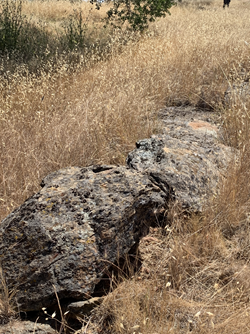
District 10 photo by Erin McQueary
By Erin McQueary
District 10 public information officer
On a warm spring day in May, two members of District 10’s environmental team traveled to Tuolumne County to survey an environmentally sensitive area (ESA) along State Route 49.
Archaeologist Sarah Luce and biologist David Moore inspected trees to ensure none was marked for removal within the project area for a vegetation management program.
The site is a collection area for the Tuolumne Band of Me-Wuk, a place the tribe uses to harvest willow for basketry and willow mushrooms that grow on dead or live alders, oak and willow trees. It’s up to Luce and Moore to protect this and hundreds more ESAs throughout District 10 from project activity.
They work on up to 30 projects at a time for maintenance, emergency director’s orders, local assistance, encroachment permits and intergovernmental reviews.
The two often work as a pair, with Moore responsible for federally endangered or threatened animal and plant species, and Luce for areas of cultural significance to tribes and of historical importance to California.
Hours of database research from past surveys and site visits provide the information they need to identify resources and make recommendations to protect, mitigate the impact, or relocate them. Their recommendations require coordination and approval from federal and state permitting agencies and must pass muster of laws like the California Environmental Quality Act.
They say biological protections are more widely accepted and understood by stakeholders and the public than protections for cultural resources.
“We are stewards of all cultural resources within our right of way,” Luce said. “If more people knew we own this part of history within our right of way I think people would be a little bit more understanding.”
At another site visit in Tuolumne County, along State Route 120 where a safety project will install flashing beacons on warning signs for a sharp curve, Luce inspected a quarter-mile-long stone wall mostly obscured in the tall gold grass. She said the wall could be associated with a more than century-old wagon road and she is now working with the project team to amend the design to avoid it when trenching for an electrical connection.
Anything older than 50 years is considered historic, Luce said. Shafts, tools and waste rocks associated with gold mining; remnants of cabins and other structures; and even trash scatters (old food and beer cans from laborers who built the highways decades ago) are common historical resources in District 10, she said. Structures of cultural and historical significance to the Native Americans include bedrock mortars for grinding plants and making acorn flour.

District 10 photo by Erin McQueary
At the SR-120 project location, Moore looked for riparian habitat near a culvert in the center median that conveys water to rivers or larger drainage networks downhill.
“It’s Caltrans’ responsibility to make sure that our construction doesn’t indirectly affect a feature down the road,” he said. “Construction equipment, oil from vehicles, or just silt can impact fish, frogs and water quality for people.”
Moore started his environmental science career as an Airfield Operations Manager (staff sergeant) in the Air Force.
Bird strikes cause some of the greatest damage to airplanes; it was Moore’s job to create an inhospitable environment for the birds and their prey on the airfield.
For the past six years, Moore has done the opposite at Caltrans: preserving habitat and “advocating for the natural resources that don’t have a voice but play an important part in the long-term sustainability of California,” he said.
Advocacy is both Moore's and Luce’s favorite part of their roles at Caltrans.
Depending on the funding for the project, Luce is only legally required to consult with federally recognized tribes. Most of the more than 20 tribes in District 10 are not federally recognized, but Luce strives to ensure each has a seat at the table. She has spent five years at Caltrans, working to build trust with the tribes and advocating to preserve cultural resources in place.
Moore and Luce’s values in their work align with Caltrans' values of being a people-first organization; integrity through ethical actions; and innovation through finding solutions to leave as many resources as possible untouched or restoring a site after a project, as if Caltrans was never there.

